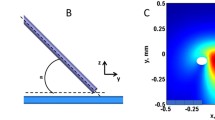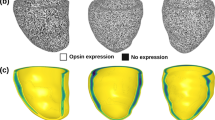Abstract
Multidirectional defibrillation protocols have shown better efficiency than monodirectional; still, no testing was performed to assess cell lethality. We investigated lethality of multidirectional defibrillator-like shocks on isolated cardiomyocytes. Cells were isolated from adult male Wistar rats and plated into a perfusion chamber. Electrical field stimulation threshold (ET) was obtained, and cells were paced with suprathreshold bipolar electrical field (E) pulses. Either one monodirectional high-intensity electrical field (HEF) pulse aligned at 0° (group Mono0) or 60° (group Mono60) to cell major axis or a multidirectional sequence of three HEF pulses aligned at 0°, 60°, and 120° each was applied. If cell recovered from shock, pacing was resumed, and a higher amplitude HEF, proportional to ET, was applied. The sequence was repeated until cell death. Lethality curves were built by means of survival analysis from sub-lethal and lethal E. Non-linear fit was performed, and E values corresponding to 50% probability of lethality (E50) were compared. Multidirectional groups presented lethality curves similar to Mono0. Mono60 displayed the highest E50. The novel data endorse the idea of multidirectional stimuli being safer because their effects on lethality of individual cells were equal to a single monodirectional stimulus, while their defibrillatory threshold is lower.

Monodirectional and multidirectional lethality protocol comparison on isolated rat cardiomyocytes. The heart image is a derivative of “3D Heart in zBrush” (https://vimeo.com/65568770) by Laloxl, used under CC BY 3.0 (https://creativecommons.org/licenses/by/3.0/legalcode)/image extracted from original video.




Similar content being viewed by others
References
Dosdall DJ, Fast VG, Ideker RE (2010) Mechanisms of defibrillation. Annu Rev Biomed Eng 12:233–258. https://doi.org/10.1146/annurev-bioeng-070909-105305
Salcido DD, Sundermann ML, Koller AC, Menegazzi JJ (2015) Incidence and outcomes of rearrest following out-of-hospital cardiac arrest. Resuscitation 86:19–24. https://doi.org/10.1016/j.resuscitation.2014.10.011
Bhardwaj A, Ikeda DJ, Grossestreuer AV, Sheak KR, Delfin G, Layden T, Abella BS, Leary M (2017) Factors associated with re-arrest following initial resuscitation from cardiac arrest. Resuscitation 111:90–95. https://doi.org/10.1016/j.resuscitation.2016.12.007
Yabe S, Smith WM, Daubert JP et al (1990) Conduction disturbances caused by high current density electric fields. Circ Res 66:1190 LP–1191203
Jones JL, Jones RE, Balasky G (1987) Microlesion formation in myocardial cells by high-intensity electric field stimulation. Am J Phys 253:H480–H486
Weaver JC (1994) Molecular basis for cell membrane electroporation. Ann N Y Acad Sci 720:141–152. https://doi.org/10.1111/j.1749-6632.1994.tb30442.x
Tung L (1996) Detrimental effects of electrical fields on cardiac muscle. Proc IEEE 84:366–378. https://doi.org/10.1109/5.486740
Krauthamer V, Jones JL (1997) Calcium dynamics in cultured heart cells exposed to defibrillator-type electric shocks. Life Sci 60:1977–1985. https://doi.org/10.1016/S0024-3205(97)00162-8
Oliveira PX, Bassani RA, Bassani JWM (2008) Lethal effect of electric fields on isolated ventricular myocytes. IEEE Trans Biomed Eng 55:2635–2642. https://doi.org/10.1109/TBME.2008.2001135
Klee M, Plonsey R (1976) Stimulation of spheroidal cells—the role of cell shape. IEEE Trans Biomed Eng BME-23:347–354. https://doi.org/10.1109/TBME.1976.324597
Ranjan R, Thakor NV (1995) Electrical stimulation of cardiac myocytes. Ann Biomed Eng 23:812–821. https://doi.org/10.1007/BF02584480
Fonseca AVS, Bassani RA, Oliveira PX, Bassani JWM (2013) Greater cardiac cell excitation efficiency with rapidly switching multidirectional electrical stimulation. IEEE Trans Biomed Eng 60(1):28–34. https://doi.org/10.1109/TBME.2012.2220766
Pagan-Carlo LA, Allan JJ, Spencer KT, Birkett CL, Myers R, Kerber RE (1998) Encircling overlapping multipulse shock waveforms for transthoracic defibrillation. J Am Coll Cardiol 32:2065–2071. https://doi.org/10.1016/S0735-1097(98)00486-0
Exner D, Yee R, Jones DL, Klein GJ, Mehra R (1994) Combination biphasic waveform plus sequential pulse defibrillation improves defibrillation efficacy of a nonthoracotomy lead system. J Am Coll Cardiol 23:317–322. https://doi.org/10.1016/0735-1097(94)90413-8
Viana MA, Bassani RA, Petrucci O, Marques DA, Bassani JWM (2016) System for open-chest, multidirectional electrical defibrillation. Res Biomed Eng 32:74–84. https://doi.org/10.1590/2446-4740.02015
Bassani RA, Lima KA, Gomes PAP, Oliveira PX, Bassani JWM (2006) Combining stimulus direction and waveform for optimization of threshold stimulation of isolated ventricular myocytes. Physiol Meas 27:851–863. https://doi.org/10.1088/0967-3334/27/9/008
Penna LB, Bassani RA (2010) Increased spontaneous activity and reduced inotropic response to catecholamines in ventricular myocytes from footshock-stressed rats. Stress 13:73–82. https://doi.org/10.3109/10253890902951778
Prado LN, Goulart JT, Zoccoler M, Oliveira PX (2016) Ventricular myocyte injury by high-intensity electric field: effect of pulse duration. Gen Physiol Biophys 35:121–130. https://doi.org/10.4149/gpb_2015047
Goulart JT, Oliveira PX, Bassani JWM, Bassani RA (2012) The influence of cell dimensions on the vulnerability of ventricular myocytes to lethal injury by high-intensity electrical fields. Res Biomed Eng 28:337–345. https://doi.org/10.4322/rbeb.2012.040
Kinosita K, Ashikawa I, Saita N et al (1988) Electroporation of cell membrane visualized under a pulsed-laser fluorescence microscope. Biophys J 53:1015–1019. https://doi.org/10.1016/S0006-3495(88)83181-3
Katz B (1937) Experimental evidence for a non-conducted response of nerve to subthreshold stimulation. Proc R Soc London Ser B, Biol Sci 124:244–276
Vernhes M-C, Cabanes P-A, Teissie J (1999) Chinese hamster ovary cells sensitivity to localized electrical stresses. Bioelectrochem Bioenerg 48:17–25. https://doi.org/10.1016/S0302-4598(98)00239-6
Canatella PJ, Karr JF, Petros JA, Prausnitz MR (2001) Quantitative study of electroporation-mediated molecular uptake and cell viability. Biophys J 80:755–764. https://doi.org/10.1016/S0006-3495(01)76055-9
Steinhardt RA, Bi G, Alderton JM (1994) Cell membrane resealing by a vesicular mechanism similar to neurotransmitter release. Science 263:390–393. https://doi.org/10.1126/science.7904084
Togo T, Alderton JM, Bi GQ, Steinhardt RA (1999) The mechanism of facilitated cell membrane resealing. J Cell Sci 112:719–731
Spaeth CS, Boydston EA, Figard LR, Zuzek A, Bittner GD (2010) A model for sealing plasmalemmal damage in neurons and other eukaryotic cells. J Neurosci 30:15790–15800. https://doi.org/10.1523/JNEUROSCI.4155-10.2010
Sambelashvili AT, Nikolski VP, Efimov IR (2004) Virtual electrode theory explains pacing threshold increase caused by cardiac tissue damage. Am J Physiol Heart Circ Physiol 286:H2183–H2194. https://doi.org/10.1152/ajpheart.00637.2003
Al-Khadra A, Nikolski V, Efimov IR (2000) The role of electroporation in defibrillation. Circ Res 87:797–804. https://doi.org/10.1161/01.RES.87.9.797
Coster HGL, Zimmermann U (1975) The mechanism of electrical breakdown in the membranes of Valonia utricularis. J Membr Biol 22:73–90. https://doi.org/10.1007/BF01868164
Knisley SB, Smith WM, Ideker RE (1994) Prolongation and shortening of action potentials by electrical shocks in frog ventricular muscle. Am J Phys 266:H2348–H2358
Acknowledgement
The authors would like to acknowledge the team of the R&D staff at CEB/UNICAMP for the technical support.
Funding
This work was supported by CNPq (National Council for Scientific and Technological Development, scholarship to MSc José Américo Nabuco Leva Ferreira de Freitas), FAPESP (Foundation for Research of the State of São Paulo (Proc. No. 2014/18.798-1)), and CAPES (Coordination of Improvement of Higher Education Personnel, scholarships to MSc Fernanda dos Santos Costa Leomil, MSc Marcelo Zoccoler, and MSc Priscila Correia Antoneli).
Author information
Authors and Affiliations
Corresponding author
Ethics declarations
All procedures performed in studies involving animals were in accordance with the ethical standards of the institutional Committee of Ethics in Animal Use (CEUA/IB/UNICAMP, protocol numbers 4093-1(I) and 4093-1(K)).
Conflict of interest
The authors declare that they have no conflict of interest.
Rights and permissions
About this article
Cite this article
de Freitas, J.A.N.L.F., dos Santos Costa Leomil, F., Zoccoler, M. et al. Cardiomyocyte lethality by multidirectional stimuli. Med Biol Eng Comput 56, 2177–2184 (2018). https://doi.org/10.1007/s11517-018-1848-6
Received:
Accepted:
Published:
Issue Date:
DOI: https://doi.org/10.1007/s11517-018-1848-6




